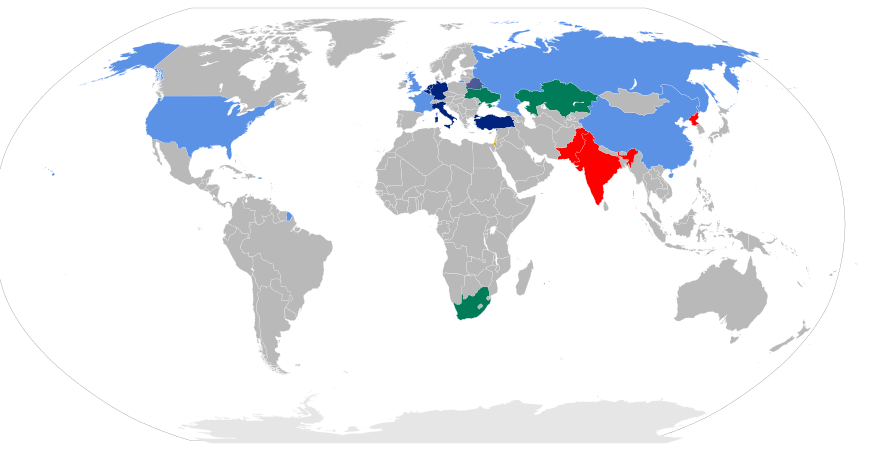Countries with nuclear arsenal
These can be classified into five types:
- Countries which have entered into NPT
- Countries which haven't entered into the NPT
- Countries which are believed to have nuclear war-heads
- NATO (war-head sharing countries)
- states formerly possessing nuclear war-heads
Countries which have entered into NPT:
Under "non-proliferation treaty" five countries are considered to be "nuclear weapon states".
They are
1. USA (7315)
2. Russia (8000)
3. France (300)
4. United kingdom (225)
5. China (250)
USA has build nearly 70,000 nuclear war heads during 1949 cold war, and Russia has build nearly 55,000. These weapons are said to be decommissioned or partially stored, but are "not destroyed"
Countries which haven't entered into the NPT:
Since the NPT entered into force in 1970, three states that were not parties to the Treaty have conducted nuclear tests, namely India, Pakistan, and North Korea. North Korea had been a party to the NPT but withdrew in 2003.
Countries which are believed to have nuclear war-heads:
Israel is widely believed to have been the sixth country in the world to develop nuclear weapons, with “rudimentary, but deliverable,” nuclear weapons available as early as 1967. Israel is not a party to the NPT. Israel engages in strategic ambiguity, saying it would not be the first country to "introduce" nuclear weapons into the region, but refusing to otherwise confirm or deny a nuclear weapons program or arsenal. This policy of "nuclear opacity" has been interpreted as an attempt to get the benefits of deterrence with a minimum political cost. In 1968, the Israeli Ambassador to the United States, Yitzhak Rabin, affirmed to the United States State Department that Israel would "not be the first to introduce nuclear weapons into the Middle East." Upon further questioning about what "introduce" meant in this context, however, he said that "he would not consider a weapon that had not been tested a weapon," and affirmed that he did not believe that "an unadvertised, untested nuclear device" was really "a nuclear weapon." He also agreed, however, that an "advertised but untested" device would be considered "introduction." This has been interpreted to mean that official Israeli policy was that the country could possess a nuclear weapon without technically "introducing" it, so long as it did not test it, and as long as it was "unadvertised".
According to the Natural Resources Defense Council and the Federation of American Scientists, Israel likely possesses around 75–200 nuclear weapons.
NATO (war-head sharing countries):
- Under NATO nuclear weapons sharing, the United States has provided nuclear weapons for Belgium,Germany, Italy, the Netherlands, and Turkey to deploy and store. This involves pilots and other staff of the "non-nuclear" NATO states practicing, handling, and delivering the U.S. nuclear bombs, and adapting non-U.S. warplanes to deliver U.S. nuclear bombs. However, since all U.S. nuclear weapons are protected with Permissive Action Links, the host states cannot arm the bombs without authorization codes from the United States Air Force. U.S. nuclear weapons were also deployed in Canada until 1984, and in Greece until 2001 for nuclear sharing purposes.
- Members of the Non-Aligned Movement have called on all countries to "refrain from nuclear sharing for military purposes under any kind of security arrangements." The Institute of Strategic Studies Islamabad (ISSI) has criticized the arrangement for allegedly violating Articles I and II of the NPT, arguing that "these Articles do not permit the NWS to delegate the control of their nuclear weapons directly or indirectly to others." NATO has argued that the weapons' sharing is compliant with the NPT because "the U.S. nuclear weapons based in Europe are in the sole possession and under constant and complete custody and control of the United States.
states formerly possessing nuclear war-heads:
South Africa, Belarus, Ukraine, Kazakhstan are known to be states which possess nuclear warheads but disposed them later.
Ukraine used to have nearly 5,000 nuclear war heads before the separation from the soviet union. But it has voluntarily disposed them.
Other states believed to have nuclear weapons (Israel)

Comments
Post a Comment